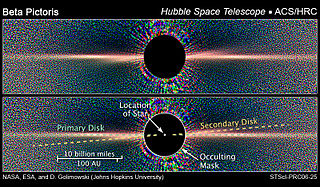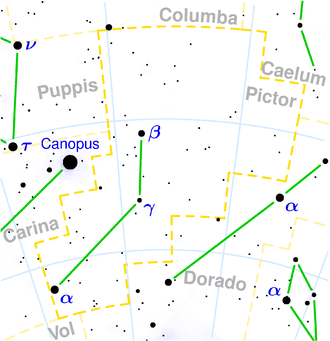Beta Pictoris
|
Star β Pictoris |
|||||||||||||||||||
|---|---|---|---|---|---|---|---|---|---|---|---|---|---|---|---|---|---|---|---|

|
|||||||||||||||||||
| HST image of the dust discs around Beta Pictoris (the star itself is covered) | |||||||||||||||||||
| AladinLite | |||||||||||||||||||
|
Observation dates equinox : J2000.0 , epoch : J2000.0 |
|||||||||||||||||||
| Constellation | painter | ||||||||||||||||||
| Right ascension | 05 h 47 m 17.09 s | ||||||||||||||||||
| declination | -51 ° 03 ′ 59.5 ″ | ||||||||||||||||||
| Apparent brightness | 3.85 (3.80 to 3.86) mag | ||||||||||||||||||
| Typing | |||||||||||||||||||
| Known exoplanets | 2 | ||||||||||||||||||
| B − V color index | +0.17 | ||||||||||||||||||
| U − B color index | +0.10 | ||||||||||||||||||
| R − I index | +0.16 | ||||||||||||||||||
| Spectral class | A6 V | ||||||||||||||||||
| Variable star type | DTSC + EP | ||||||||||||||||||
| Astrometry | |||||||||||||||||||
| Radial velocity | (20.0 ± 0.7) km / s | ||||||||||||||||||
| parallax | (51.44 ± 0.12) mas | ||||||||||||||||||
| distance | (63.41 ± 0.15) Lj (19.44 ± 0.05) pc |
||||||||||||||||||
| Visual absolute brightness M vis | +2.4 mag | ||||||||||||||||||
| Proper movement | |||||||||||||||||||
| Rec. Share: | (+4.65 ± 0.11) mas / a | ||||||||||||||||||
| Dec. portion: | (+83.10 ± 0.15) mas / a | ||||||||||||||||||
| Physical Properties | |||||||||||||||||||
| Dimensions | (1.700 ± 0.085) M ☉ | ||||||||||||||||||
| radius | (1.459 ± 0.073) R ☉ | ||||||||||||||||||
| Luminosity |
(8.7) L ☉ |
||||||||||||||||||
| Age | (23 ± 3) million a | ||||||||||||||||||
|
Other names and catalog entries |
|||||||||||||||||||
|
|||||||||||||||||||
Beta Pictoris ( β Pictoris or β Pic for short ) is the second brightest star in the painter constellation . The massive, hot star is about 63 light years away and plays a significant role in the history of astronomy . The star is a member and namesake of the β-Pictoris cluster of movements . In 2008, an exoplanet was discovered in its orbit by direct observation .
properties
The star Beta Pictoris is still extremely young at around 20 million years and is only at the beginning of the main sequence phase . Due to pulsations , its apparent brightness fluctuates slightly between 3.80 and 3.86 with a period of only 37 minutes.
history
In 1983 a disk of dust was discovered around Beta Pictoris with the infrared satellite IRAS , and a year later it was photographed with an earth-based telescope. The dust disk has a radius of 400 astronomical units . Planets could possibly form in the dust disk . In 1995, images from the Hubble Space Telescope indicated a warping of the inner portion of the disk. Renewed Hubble space telescope observations with the high-resolution Advanced Camera for Surveys were able to prove that the bent disc actually consists of two intertwined dust discs inclined by 4 degrees . One explanatory model was the assumption of a planet or brown dwarf of 20 Jupiter masses orbiting the star.
In an image taken with the VLT in 2003, an object with about eight times the mass of Jupiter was found near Beta Pictoris. After this had not appeared in later recordings, it could be found again on a picture taken in autumn 2009 and evaluated in June 2010 ( Anne-Marie Lagrange et al.). With this observation, the existence of an exoplanet orbiting Beta Pictoris at a distance that roughly corresponds to the orbit of Saturn around the sun was proven . Furthermore, it was the first time that such an object was able to be held in position on both sides of its central star. It is possible that a passage of the exoplanet called Beta Pictoris b is responsible for a slight decrease in brightness at Beta Pictoris, which took place in 1981 and was already noticed in an analysis published in 1995 of data from the observatory of the University of Geneva on La Silla . Upon further observation, it was found that Beta Pictoris b only rotated for about 8 hours. In 2019, the mass of the exoplanet was determined to be 12.9 ± 0.5 M J at around 1.65 R J , making the planet almost a brown dwarf . The major semi-axis of the planet's orbit around its central star is 11.8 ± 0.9 AU and it takes about 30 years to complete one orbit.

In August 2019, the discovery of a second planet was announced: Beta Pictoris c has about 9 times the mass of Jupiter. Its mean distance to the central star corresponds to about a third of that of Beta Pictoris b .
See also
Web links
- Beta Pictoris planet finally imaged? (English) - ESO press release , November 21, 2008
Individual evidence
- ↑ a b Hipparcos catalog (ESA 1997)
- ↑ a b c NSV 16683. In: VSX. AAVSO , accessed August 24, 2018 .
- ↑ a b c Bright Star Catalog
- ↑ a b c d Eric E. Mamajek, Cameron PM Bell: On the age of the beta Pictoris moving group . In: Monthly Notices of the Royal Astronomical Society . 445, No. 3, 2014, pp. 2169-2180. arxiv : 1409.2737 . bibcode : 2014MNRAS.445.2169M . doi : 10.1093 / mnras / stu1894 .
- ↑ Pulkovo radial velocities for 35493 HIP stars
- ↑ a b c Hipparcos, the New Reduction (van Leeuwen, 2007)
- ↑ a b P. E. Kervella, F. Arenou, F. Mignard, F. Thévenin: Stellar and substellar companions of nearby stars from Gaia DR2. Binarity from proper motion anomaly . In: Astronomy & Astrophysics . 623, p. A72. arxiv : 1811.08902 . bibcode : 2019A & A ... 623A..72K . doi : 10.1051 / 0004-6361 / 201834371 .
- ↑ Crifo, F .: β Pictoris revisited by Hipparcos. Star properties . In: Astronomy & Astrophysics . 320, 1997, pp. L29-L32. bibcode : 1997A & A ... 320L..29C .
- ^ T. Althaus .: Two dust discs around Beta Pictoris . In: Stars and Space . 8/2006, Spektrum Verlag, ISSN 0039-1263
- ↑ An exoplanet changes sides . www.eso.org. June 10, 2010. Retrieved February 25, 2012.
- ↑ A.- M. Lagrange, M. Bonnefoy, G. Chauvin, D. Apai, D. Ehrenreich, A. Boccaletti, D. Gratadour, D. Rouan, D. Mouillet, S. Lacour, M. Kasper: A Giant Planet Imaged in the Disk of the Young Star β Pictoris . In: Science . 329, No. 5987, June 10, 2010, pp. 57-59. ISSN 0036-8075 , ISSN 1095-9203 . doi : 10.1126 / science.1187187 .
- ↑ First planetary observation in 1981? - Article at astronews.com , March 31, 2009
- ^ Rufener, F .: Catalog of stars measured in the Geneva Observatory photometric system (fourth edition) ; in: Astronomy and Astrophysics Supplement Series ( ISSN 0365-0138 ), Vol. 78, No. 3, June 1989, p. 469ff. bibcode : 1989A & AS ... 78..469R
- ↑ Lecavelier Des Etangs et al .: β Pictoris: evidence of light variations ; in: Astronomy and Astrophysics, Vol. 299, p. 557, 1995, bibcode : 1995A & A ... 299..557L
- ^ Missed discovery honor - article in the FAZ , April 8, 2009
- ↑ For the first time the length of an exoplanet was measured . www.welt.de. April 30, 2014. Retrieved May 1, 2014.
- ↑ beta pic b. In: Extrasolar Planets Encyclopaedia . Retrieved November 15, 2019 .
- ↑ A.-M. Lagrange, Pascal Rubini Meunier, Miriam Keppler, Franck Galland, et al. : Evidence for an additional planet in the β Pictoris system . In: Nature Astronomy . August 19, 2019. doi : 10.1038 / s41550-019-0857-1 . Retrieved August 20, 2019.
- ^ New planet discovered in the orbit of young Milky Way star; said to be 3,000 times Earth's size- Technology News, Firstpost . 20th August 2019.
